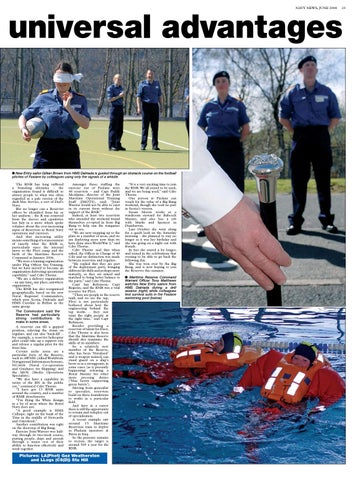NAVY NEWS, JUNE 2008
23
universal advantages
● New Entry sailor Gillian Brown from HMS Dalriada is guided through an obstacle course on the football pitches of Faslane by colleagues using only the signals of a whistle The RNR has long suffered a branding dilemma – the organisation found it difficult to attract people to what was often regarded as a pale version of the dark blue Service, a sort of Dad’s Navy. But no longer can a Reservist officer be identified from his or her uniform – the R was removed from the sleeves and epaulettes last July in a move which spoke volumes about the ever-increasing input of Reservists to Royal Navy operations and exercises. And that increasing utility means something of a reassessment of exactly what the RNR is, particularly since the internal move to the Fleet camp and the birth of the Maritime Reserve Command in January 2006. “We were a training organisation under Flag Officer Sea Training, but we have moved to become an organisation delivering operational capability,” said Cdre Thorne. “We are a delivery organisation – an any time, any place, anywhere organisation.” The RNR has also reorganised geographically, based on the new Naval Regional Commanders, which puts Scotia, Dalriada and HMS Caroline in Belfast in the same group. The Commodore said the Reserve had particularly strong contributions to make in some areas. A reservist can fill a gapped position, relieving the strain on regulars, and can also ‘back-fill’ – for example, a reservist helicopter pilot could take up a support role and release a regular pilot for the front line. Certain niche areas are a particular forte of the Reserve, such as AWNIS (Allied Worldwide Navigational Information System), NCAGS (Naval Co-operation and Guidance for Shipping) and the MOS (Media Operations Specialists). “We also have a capability in terms of the RN in the public eye,” continued Cdre Thorne. “I have got 13 RNR units around the country, and a number of RMR detachments. “I’m flying the White Ensign in a lot of areas where the Royal Navy does not. “A good example is HMS Calliope, right on the bank of the Tyne in the middle of Newcastle and Gateshead.” Another contribution was right on the doorstep of Big Bang. Exercise Joint Warrior was halfway through its two-week course, putting people, ships and aircraft through a major test of their ability to function effectively and work together.
Amongst those staffing the exercise out of Faslane were 48 reservists – and Capt Paddy McAlpine, director of the Joint Maritime Operational Training Staff (JMOTS), said: “Joint Warrior would not be able to exist in its current form without the support of the RNR.” Indeed, at least two reservists who attended the weekend found themselves co-opted in from Big Bang to help run the wargames out to sea. “We are now stepping up to the plate in a number of areas, and we are deploying more now than we have done since World War 2,” said Cdre Thorne. Cdre Thorne said that when asked, the Officer in Charge of 40 Cdo said no distinction was made between reservists and regulars. “He replied that they are part of the deployment party, bringing different life skills and perhaps more maturity, so they are mixed and matched to bring better balance to the party,” said Cdre Thorne. Capt Ian Robinson, Capt Regions, said the RNR was a vital resource for Fleet. “There are people in the reserve tank, and we are the tap; Fleet is not particularly bothered about how the engineering behind the tap works – they just want the right people at the right time,” said Capt Robinson. Besides providing a reservoir of talent for Fleet, Cdre Thorne is also keen that the Maritime Reserve should also maximise the skills of its members. So a relatively new member of the Reserve, who has been ‘Navalised’ and is weapon trained, can stand guard on a ship’s brow or in a strongpoint, in some cases (as it presently happening) releasing a Royal Marine for other more pressing duties (‘blue berets supporting green berets’). Moving from generalist to specialist, reservists build on those foundations to works in a particular field. And later in a career there is still the opportunity to retrain and redeploy out of specialisation. A recent example saw around 15 Maritime Reservists train to deploy as Phalanx operators at Basra in Iraq. So the pressure remains to recruit, the target is around 500 a year for the RNR.
Pictures: LA(Phot) Gaz Weatherston and LLogs (CS(D)) Stu Hill
“It is a very exciting time to join the RNR. We all joined to be used, and we are being used,” said Cdre Thorne. One person at Faslane can vouch for the value of a Big Bang weekend, though she took no part in Scotia’s version. Susan Morris works as a wardroom steward for Babcock Marine, and also has a job with Marks and Spencer in Dumbarton. Last October she went along for a quick look on the Saturday morning – she planned to stay no longer as it was her birthday and she was going on a night out with friends. In fact she stayed a lot longer, and reined in the celebrations that evening to be able to go back the following day. She was won over by the Big Bang, and is now hoping to join the Reserves this summer. ● Maritime Reserve Command Warrant Officer Tony Matthews watches New Entry sailors from HMS Dalriada during a drill session (right) while colleagues test survival suits in the Faslane swimming pool (below)
